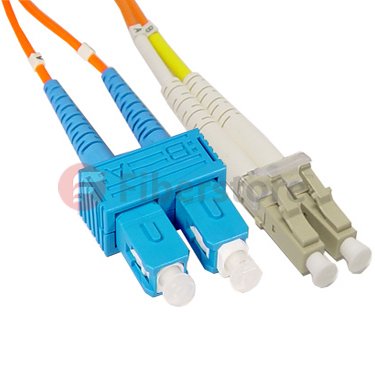Optical fiber communication refers to modulate voice, video and data signals to the fiber patch cord as a communication transmission medium. The optical fiber can be divided into multimode fiber and single mode fiber.
Single Mode Fiber Patch Cord
The central glass core of single mode fiber is fine (core diameter is usually 9 or 10μm), it only can transfer one mode light. The mode dispersion is small, and it is for remote communication, but it plays a major role in the chromatic dispersion so that the spectral width of the single mode fiber has a higher light stability and the requirement that the spectral width is narrower and better stability. 1000 Mb/s fiber optic transmission distance is 550m-100km. As we all know, we commonly see 9/125μm single mode optical fiber in the market. And single mode 9/125um fiber optic patch cables are recommended for Fast, Gigabit, 10G Ethernet or SONET OC3-OC192 rate optical connections. Low prices make the 9/125um fiber attractive for in-building projects too, because of the reliability and choice of using a single-strand of fiber for same communications (simplex cords are used on Bi-Directional data links).
Multimode Fiber Patch Cord
The central glass core of Multimode fiber is coarse (50 or 62.5μm), multiple modes of light can pass. However, its mode dispersion is among large, which limits the frequency of the transmitted digital signal, and with the increase in distance will be more severe. Multi-mode fiber transmission distance is relatively recent, generally only a few kilometers. 1000 Mb/s fiber optic transmission distance is 220m-550m. In general, we can find 62.5/125um Multi-mode fiber optic cable in the market. 62.5/125um multimode fiber cables are recommended for Fast Ethernet and up to OC3/STM1 rate optical connections. They can also be used for Gigabit Ethernet multi-mode connections on distances less than 275 meters. 62.5/125um fiber is most used inside buildings.
Types of Fiber Patch Cord
In the network wiring, the more applications optic fiber has three types, there are 62.5μm/125μm multimode fiber, 50μm/125μm multimode fiber, and 9μm/125μm single mode fiber. According to the rate and transmission distance, we can distinguish and choose single/multimode optic fiber. Tied the fiber bundle, outside has the protective housing, which is called fiber cable. According to different application environments, the cable can be divided into indoor and outdoor fiber optic cable.
Fiber refers that the fiber jumper with a desktop computer or device connected directly to facilitate the connection and manage the device. Fiber jumpers are also divided into two multimode and single-mode, which are connected with single mode and multimode fiber. Jumper for an active connection cable between the two devices without connectors (as distinguished: patch (patch cord) is one or both ends with connectors; jumper is at both ends of the cable has a fiber optic connectors, the device can be directly connected, but only one end of the fiber pigtail connector and the other end to the fiber splicing).
Fiber Patch Cord Connector Types
Fiber patch cord connector shape can be divided into FC, SC, ST, LC, etc. According TO ferrule grinding mode, it can be divided into PC (plane), UPC (spherical surface), APC (8 degrees inclined plane ) and other (cable optical transceiver general requirements FC / APC connector). According to the type of optical fiber, it can be divided into the single mode optical fiber, 50/125 multimode, 62.5/125 multimode and Gigabit, etc. According to the optical fiber connetor, we commonly see LC, SC fiber patch cord in the market, the following products are LC-SC fiber in our online store, if you have interest, you can go to our store to have a see.
Fiber patch cord products are widely applied, it applies in the communications room, fiber to the home, local area networks, fiber optic sensors, fiber optic communication systems, fiber optic transmission equipment connected, defense readiness and so on. Apply to cable television, telecommunications networks, computer networks and optical fiber test equipment. Broken down mainly used in several ways.

